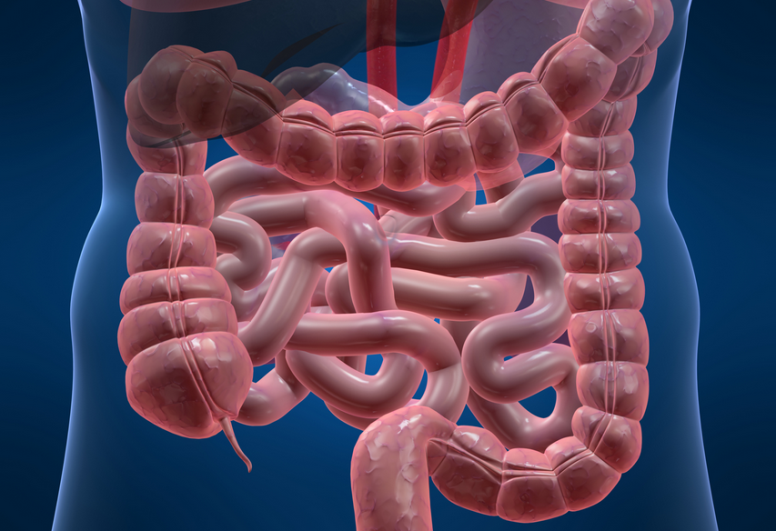This article describes the structure of the human intestines.
Contents
- The location of the internal organs of man: where is the intestines?
- Human anatomy - the internal structure of the organs of the stomach and intestines of a person in men and women: a scheme with a description in pictures with names, drawing, sequence of location
- Features of the internal structure of the small intestine of a person: photos with inscriptions in front
- Features of the internal structure of the large intestine of a person: photos with inscriptions in front
- Human intestines: building on the right, left, sigma
- The structure of the wall, human intestines
- What is the length of the human intestines: how many meters?
- Functions of human intestines: how does it work, what does it?
- Video: Human intestines structure
The human intestines are an organ in which food processing occurs, absorption of substances necessary for building and nutrition. A feces are formed from the remnants of food in this organ, which is then excreted through the colon. Read more about the intestinal anatomy in this article. You will find out where it is, what is the sequence of organs and much more. Read further.
The location of the internal organs of man: where is the intestines?
The intestines of a person is a tubular muscle organ. Active work is going on here:
- Digging of food
- The splitting of proteins, fats and carbohydrates to more simple components
- Water disposal from intestinal contents
- Sucking food products
- Promotion of food residues with feces
- The removal of undigested food residues and toxic life products
- Protection against the penetration of harmful substances and pathogens into the body
- Participation in the formation of immunity
- Effect on endocrine glands
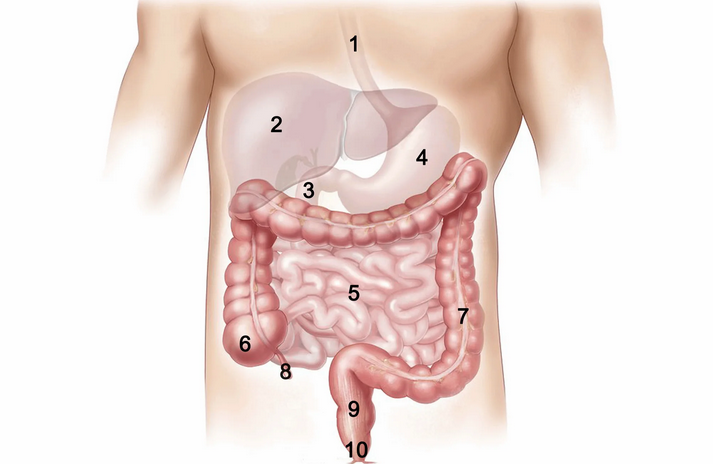
The location of the internal organs of man:
- The gastrointestinal tract is represented by the muscle tube.
- It originates from the throat, then in the form of the esophagus it goes through the chest cavity.
- Continues with stomach and intestines in the abdominal cavity and ends with the rectum.
- The intestines proceeds from the stomach and finishes the anus.
This organ is made by loops of the muscle tube, which:
- They are held inside the abdomen in a stable position of a mesentery, consisting of peritoneal leaves.
- This is a serous substance that covers the walls inside the abdomen.
- It is adjacent to the outer wall of the intestine and forms supportive structures for its stable position.
- Blood, lymph vessels and nerves pass in the mesentery.
- In front, the intestines are covered with an omentum. This is a fold of serous tissue containing adipose deposits. The oil seal performs a protective function, protects from possible injuries and inflammation.
Where is a person’s intestines? It is located in the abdomen, from the lower rib to the anus. Its location is clearly visible in the picture below.
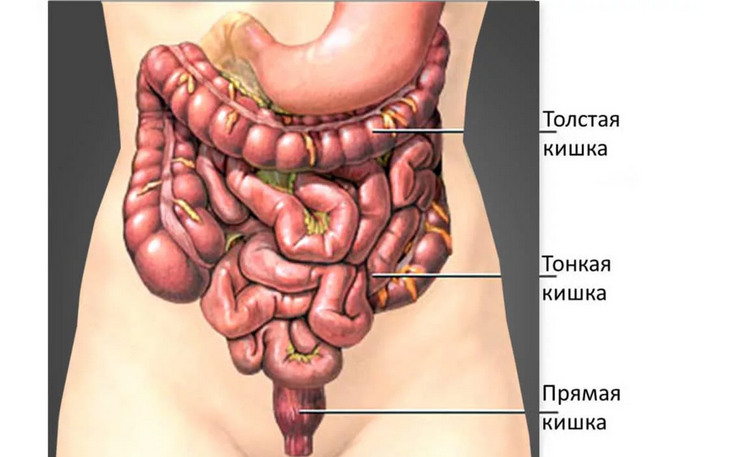
Human anatomy - the internal structure of the organs of the stomach and intestines of a person in men and women: a scheme with a description in pictures with names, drawing, sequence of location
The thin and large intestine make up the sequential components of the intestine. The thin part begins immediately after the stomach and its first department is called 12 Persian intestines, followed by skinny and iliac. The thick section is located between the thin and the anus. It is indicated by the following departments of the intestine:
- Cecum
- Rising
- Transversely collapse
- Descending
- Sigmoid
- Straight
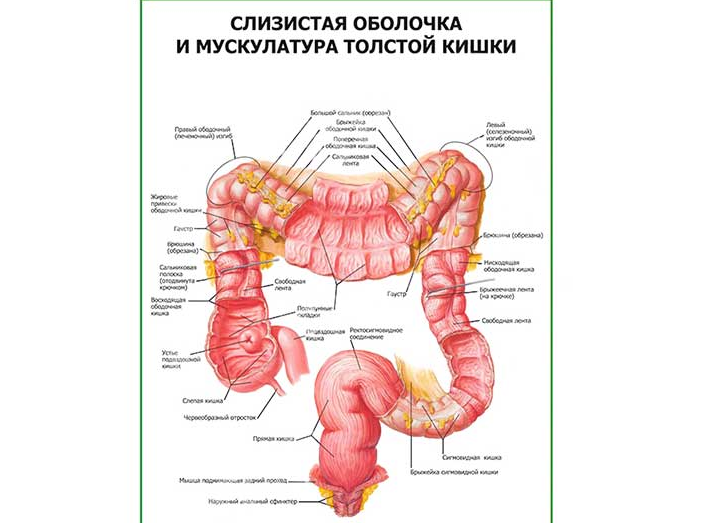
Anatomically the structure of the intestine in people of both sexes is the same. There is a difference in some relative parameters:
- For example, relative to the female body, the colon is longer than that of men, although in absolute numbers the sizes are the same.
- The intestines of women are more labile in the abdominal cavity. It has the opportunity to shift when gesturing a child and a pressure of a pregnant uterus on him.
- The colon is approximately the same length in men and women.
- The thin longer in men, which allows the male body to absorb more nutrients when digesting and passing through the small intestine.
Here is a person’s anatomy in more detail - the internal structure of the organs of the stomach and intestines of a person in men and women with the sequence of organs:

In this figure, a scheme with a description in the pictures and names shows that in the middle of the peritoneum there is a small intestine. The large intestine, as it were, envelops him. The structure of the intestine ends with the rectum, located at the very bottom.
Features of the internal structure of the small intestine of a person: photos with inscriptions in front
The small intestine is so called due to the smaller diameter and thickness of the wall. Conventionally divided into three departments:
- Duodenum (Duodenum)
- Jejunum)
- Iliac (ileum)
Here are the features of the internal structure of the small intestine - a photo with the inscriptions in front:
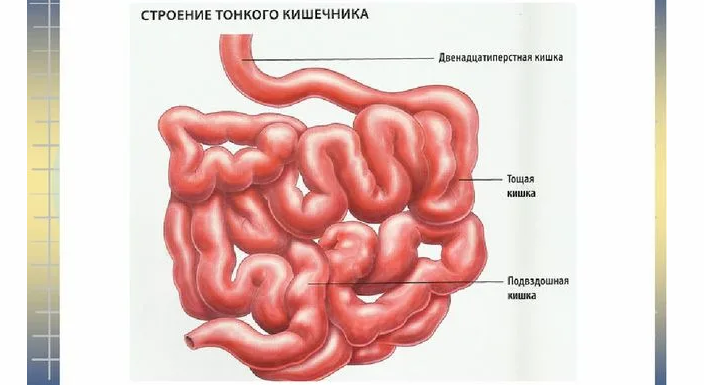
- The duodenum begins immediately after the lateral stomach, is located under the liver at the level of the twelfth breast and first lumbar vertebrae.
- She surrounds the head of the pancreas.
- In the middle there is an education - Faters nipplein which it is located sFINKER ODDI.
- Through it, the pancreatic juice and the secret of the liver (bile) occur.
- The small papilla is located slightly higher and the pancreatic duct also opens into it.
- Skinny and ileum in the form of loops lie in the abdominal cavity. The skinny is located on the left in the upper abdomen, and the iliac right below. There is no clear boundary between them.
The ileum is considered longer. It is 3\5 From the total size of these two parts of the small intestine.
Features of the internal structure of the large intestine of a person: photos with inscriptions in front
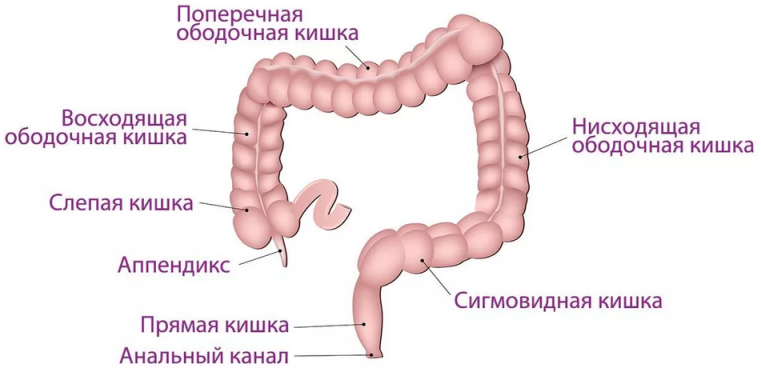
The colon is the final part of the digestive tube. It begins after the ileum and ends with the anus. Above in the photo with inscriptions in front, the features of the internal structure of the large intestine of a person are visible.
Conventionally, it is divided into the following parts:
- Blind intestine with a worm -shaped process
- Rising collapse
- The transverse collapse
- The downward collar
- Rectum
Read more in more detail below.
Human intestines: building on the right, left, sigma
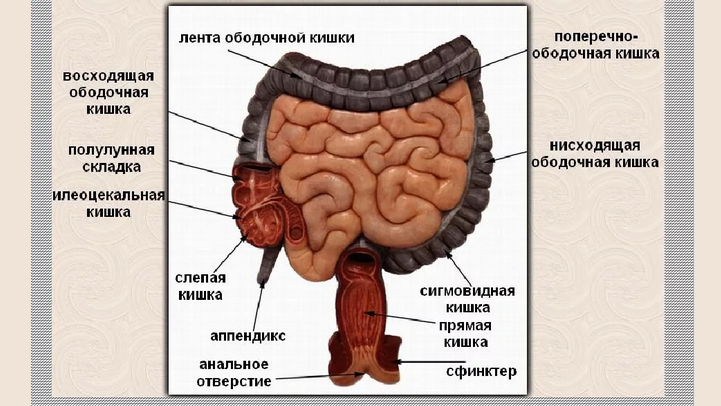
The human intestines are a complex organ with its own functions that are important for life. Here is the structure to the right and left:
- Blind gut (Caecum) It is projected on the right in the iliac region, has the shape of a hemisphere, from which it departs cherry -shaped process (Appendix).
- The transition of the ileum in the blind forms an ileocecal angle. There is a valve that does not allow the contents of the intestine back - Bauginite damper.
- Appendix is \u200b\u200ban appendage of the colon. It belongs to the components of the organs of the immunity system.
- The ascending, transverse and descending parts of the colon form the colon (Colon).
- The ascending part occupies the position on the right. She goes to the transverse department on the right under the liver.
- The transverse intestine is curved to the bottom, sometimes it lowers even below the navel.
- The descending intestine is located on the left side of the abdomen from top to bottom. At the location of the left iliac transits to the SIGMU. The colon has several sphincters to regulate its movement and promote the intestinal contents in the right direction.
- The sigmoid intestine is located on the left of the abdomen. It has S-shaped bend And already in the small pelvis passes into the rectum.
The rectum is the final department of the intestinal tube. It has an expansion for accumulating feces (ampoule), turning into narrowing (anal canal) and ends with the anus.
The structure of the wall, human intestines

The wall of the human intestines in all its departments has the same structure. It has the following structure:
- The mucous membrane
- Submissive layer
- Muscle frame
- Serosa bedspread
Read more:
- Inner shell In the small intestine, it differs in the presence of villi, circular folds and crypt (glands).
- In the colon There are no longer a villi, but weigently more crypt.
- Mucous membrane of the small intestine It consists of numerous villi, which are outgrowths of epithelium enterocytes. This increases the area of \u200b\u200bthe suction surface. Which allows adsorbing a large number of necessary nutrients.
- These formations are saturated with blood vesselsTherefore, all the ingredients enter the bloodstream immediately and are carried throughout the body.
- Due to the villi, the absorption surface increases ten times.
- The submucosal base Contains lymph and nerve plexuses. There are fat cells. It makes up the basic litter for the intestinal mucosa.
- Muscle shell It consists of longitudinal and circular smooth muscles.
- Between two layers of muscle tissue The connective tissue substance passes.
Serous fabric lines on the outside almost all intestinal parts
What is the length of the human intestines: how many meters?
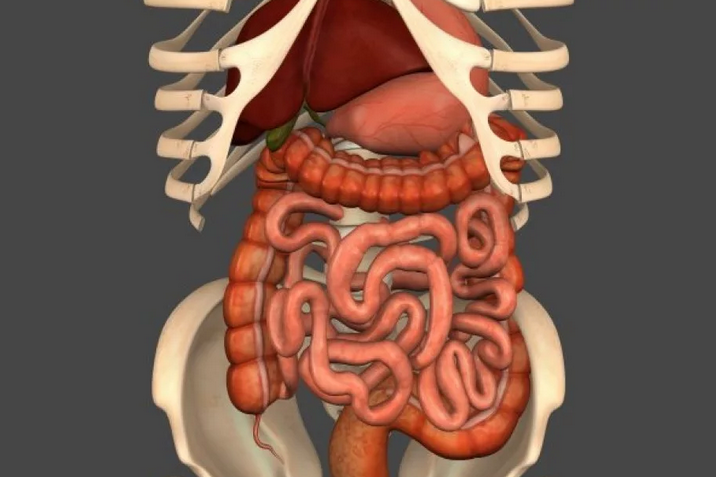
The length of all departments of the intestines in an adult is together 8-10 meters. Most of the length of the intestinal tube falls on the small intestine - 5-7 metersThe rest is thick.
The longest department is the ileum - 3-4 meters. The shortest plot is called a blind intestine and is just 3-8 cm.
Functions of human intestines: how does it work, what does it?
All intestinal departments work in the system of digestion of food, transportation, formation and withdrawal of undigested residues. What happens to food in various intestinal parts? How does it work, what does it do? Here are the functions of the human intestines:
- Colon:
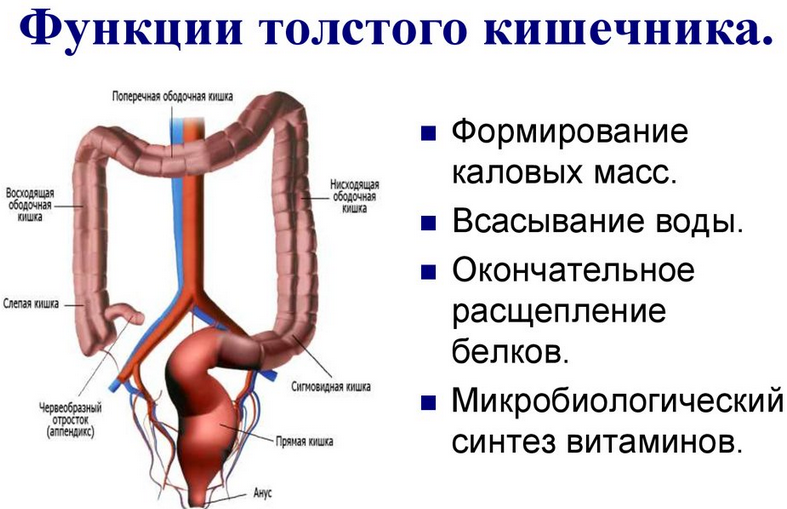
- Small intestine:

Read more - what does digestion mean:
- All foods consist of proteins, fats, carbohydrates, contain trace elements and vitamins. In the intestines, the splitting of all components is to be split to individual elements.
- Proteins are split to amino acids, fats to glycerol and fatty acids, carbohydrates to simple sugars.
- All these substances go to the construction of human body cells. There is a constant renewal of functioning cells of all organs and systems.
- Vitamins and trace elements pass into the blood through the intestinal mucosa unchanged or interact with various ingredients.
- So vitamin A is absorbed only in the presence of fats. Vitamins are accelerators of many vital reactions in the body to renew cells and energy accumulation.
- Microelements along with water stabilize cell membranes and drive water-electrolyte compliance.
- Digging occurs in small intestines. In the duodenum, the outputs of the main digestive glands are located.
- Food is exposed to bile acids and splitting enzymes of the pancreas (lipase, amylase).
- Here in the small intestine, where the mucous membrane has a special structure and all obtained by digesting the substance are absorbed.
- Through the wall of the colon, only potassium and sodium fall into the blood along with water. Excess fluid is returned to the bloodstream from the proximal parts of the colon. As a result of this, a water balance is replenished and a dense feces are formed.
If you explain the digestion process with a few words:
- The food lump moves throughout the intestines, gradually losing the beneficial properties and eventually exits through the anus in the form of feces.
Muscle fibers are promoted, located longitudinally and circular. Billions of bacteria that make up the resident flora live in the colon on the mucosa. Doctors consider these microorganisms as a whole functioning organ, a mechanism that performs many useful functions.
Due to the microflora, it occurs:
- Residual firing splitting
- The absorption of some vitamins, trace elements and water
- The formation of local immunity
- Confrontation with pathogenic bacteria entering the intestines
- Development of stimulants to stabilize immune forces
- Confrontation to allergens
- The final formation of feces
The lymph containing intestinal structures, especially appendix, play a huge role in the adequacy of the reaction of systemic immunity and is one of the important components of the endocrine glands. To a greater extent responsible for fat metabolism in the body. Many cases of obesity development after appendectomy are described.
All intestinal functions are defined as:
- Digging of food
- Sucking the necessary substances and water
- Promotion of the food lump
- The formation of digestive waste and toxic products from the body
- Maintaining local and systemic immunity
- Effect on the function of the glands of internal secretion
The intestines are a multifunctional organ, the general condition of the body depends on the coherence of the actions of which. This is an important organ, the health of which needs to be monitored.

